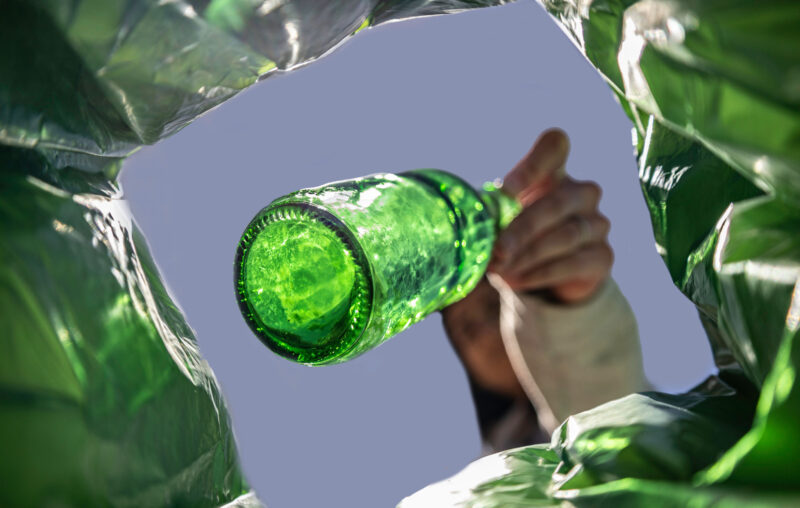Reduce, Reuse, and…Refuse?

If the definition of a “religion” is a set of beliefs, oriented around a faith, involving some sacrifice, taught to people with the goal to change their behavior, what is one ascendent religion today that nearly everyone agrees with?
It’s recycling.
It’s hard to find anyone who admits to being against it. Their recycling habits might occasionally lapse (like their prayer life), but they usually admit their error, with a little shame. Those blue recycling bins are omnipresent, it’s taught in schools, and we’re reminded to do it religiously by just about everyone.
So, is it a false religion? Should we recycle?
Yes and no.
That is economic talk for, “It’s complicated.” In economics, the initially correct answer typically is, “It depends.” Recycling can save resources, but often it is a psychically pleasing but utter waste of resources. How are we to decide?
One easy litmus test is this one, suggested by economist Dr. Dan Benjamin. Take your “should I recycle these?” items, place them in a transparent plastic bag, and set them on the curb. If they are gone tomorrow, you should’ve recycled them. If they are still there in the morning, they belong in a landfill. Your aluminum cans would likely disappear, but not your used Kleenex collection.
This simple test assumes a deeper dive into the economics of recycling. Consider two very opposite extremes:
1.) You hear of a stray 7-UP can on an alleyway in Calcutta, so you hop on a 747, fly there, pick it up, toss it into a blue bin, and fly home. You have indeed saved minuscule resources (aluminum, energy) at the expense of immense amounts of non-renewable resources (oil and time being the biggest two). Your recycling clearly wasted resources.
More realistically, I did a personal test: I saved every aluminum can and glass bottle for months, put them in plastic bags on my patio, and drove them down to our city’s recycling facility. Was it efficient?
We cannot value efficiency too much, by the way, because it is a ratio of output and input values; one cannot value values too much. So everyone should agree: we should do things only if they are efficient, comparing the output vs. the input values. Seeing choices as a series of cost/benefit ratios isn’t “just an economic” view of life; it’s the view of life for all people. Economists might disagree with non-economists on how to calculate values (does a series of prayers have diminishing marginal returns?), but it’s all about subjective costs and benefits.
In doing this experiment, I spent additional time (though not much) walking to the patio to toss cans and bottles there, some gasoline (maybe half a gallon), a few plastic garbage bags, and of course, the 45 minutes of back and forth time to recycle three large bags of nonrenewable resources. I got a bit under $5 for those (each aluminum can contains just $.02 of aluminum).
Was that efficient? Not really. The cost in resources expended included the gas — probably $3, it being California, oil to make the bags (the bags cost about $.25), and 45 minutes of my time, which, at California’s minimum wage of $15/hour, cost me $11.25. (An aside: I certainly hope my time is actually more valuable than that.) Admittedly, it turned into an economics lesson, which might have been worth, say, $20 to me. So maybe it was efficient. I did it, so yes. But only once.
2.) On the other hand, in theory, nearly every good can be efficiently recycled (meaning: it saves resources) if conditions are right.
I once worked at a large school that recycled cardboard. Normally that’s just silly. Parents dropped off flattened cardboard boxes, where retired volunteers working in a large metal shed bundled them to be picked up in trucks and transported to a recycling facility 20 miles away. For a while, it was a good fundraiser for the school.
The snarky economist in me notes a few facts:
- those calculations don’t include the grandpas’ gas used to drive to the center,
- nor do they include the opportunity costs (i.e., implicit wages) of those volunteers,
- nor do they include the opportunity costs of the heat, the electricity, and the building itself: if the building cost $100,000 to construct, at an interest rate of 5 percent, that is $5,000 per year.
But to the school it was, or seemed, efficient. Perhaps the building had no alternative use; maybe the grandpas enjoyed both the scenic trip to the recycle-fest and the camaraderie with their buddies.
So it was efficient. Until it wasn’t. Eventually, the price of cardboard collapsed, and even with those “free” inputs, it no longer made sense, and the school stopped that fundraiser.
Practically, should we use a (plastic coated) paper cup for coffee, a styrofoam cup, or a ceramic mug?
Here’s my honest and simple rule: do whatever is cheaper, assuming no negative externalities.
Which just refers to pollution, or “spillover costs.” Unless you litter, both the cardboard and the styrofoam cups will be buried, and both will last centuries, bothering no one in the oxygen and light-deprived landfill void. As long as nothing bad seeps into someone’s water supply, landfills are quite benign and we’ll never run out of them. The ceramic cup option could very well be better. Yes, its initial cost is much higher, you use energy to clean it, and it might be a pain carrying it to and fro. But the cost of each additional cup you drink will likely be lower, and perhaps it gives you not only hot coffee but warm fuzzies.
I generally put all of my paper in the trash, which I admit, is conveniently right next to the recycle bin. I happen to know that recycling paper is costly (involving bleaching of the pulp) and since it’s usually subsidized by governments, the true recycling cost is underestimated. Besides, tossing old paper into a landfill means buying more virgin paper, which increases the demand for pulp wood, which increases the amount of pulp wood grown in Canada, which helps the environment in all sorts of ways.
What about recycling bottles? Especially ones that are washed clean? Generally a hard no. They are made out of sand, and, of course, energy, but it seldom saves energy, and I think we have plenty of sand.
And plastic? Since 93 percent of plastic can’t be efficiently recycled, that’s another hard no, again, depending on the volume and the circumstances.
Certainly, batteries? I don’t know. As with most cases, it depends a lot on the scale involved, how impervious landfill linings are, the value of what we’d receive (lead, possibly cobalt), and a host of other options. Recycling Tesla batteries? Probably. Your dead button battery? I doubt it.
The last thing we want is to make our virtue signaling but inefficient recycling the modern equivalent of buying indulgences to atone for alleged environmental sins.
What are we left with?
1.) If recycling makes you feel good, do it. Normally I never say that previous phrase, especially to teenagers. It might originate from the Italian late Renaissance poet Torquato Tasso, who wrote in 1573, in an eerie premonition of the 1960s, “What pleases is permitted.” Perhaps, in this situation, it’s an acceptable mantra.
But recycling doesn’t give us permission to subsidize either recycling or landfills.
2.) If your neighbor tosses that styrofoam cup or dirty Jiffy peanut butter jar into the trash, don’t tell him he’s going to the NonRecycling hell. Just smile, assume he is an economist who argues that recycling usually wastes resources, and toss your own IKEA styrofoam peanuts mixed with broken wooden slats into the blue bin. Just don’t think about how much labor it will take to pick them out of the recycling conveyor belt to be tossed into the landfill.
Or place them in a clear plastic bag, and see if anyone picks it up. You never know.










